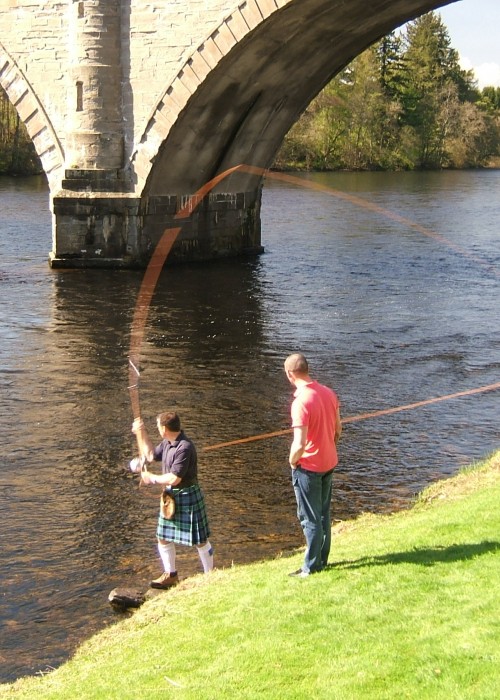
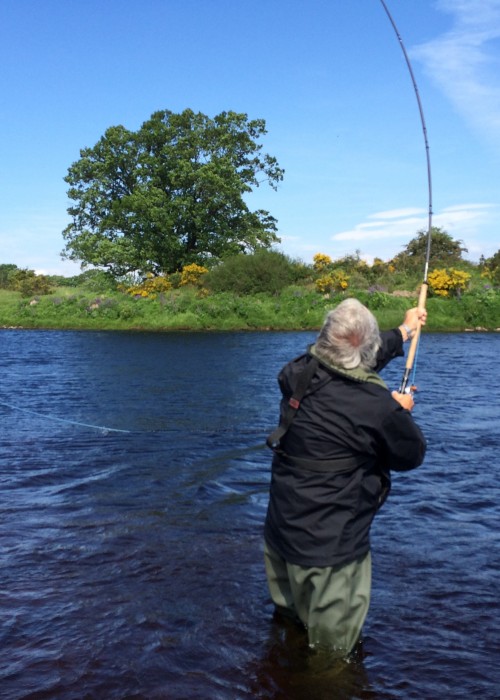
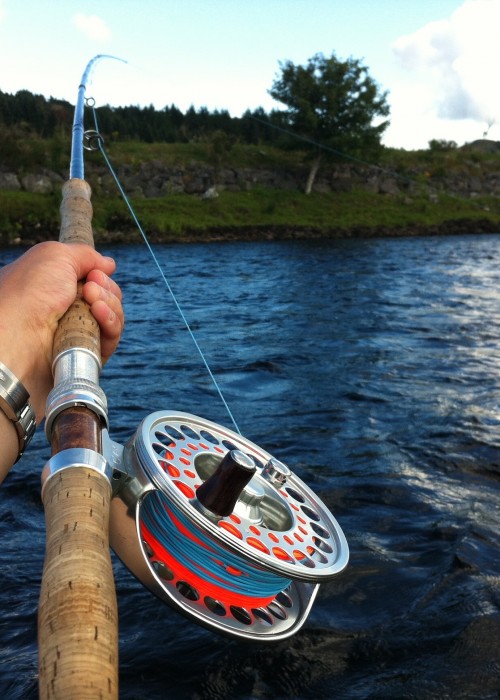

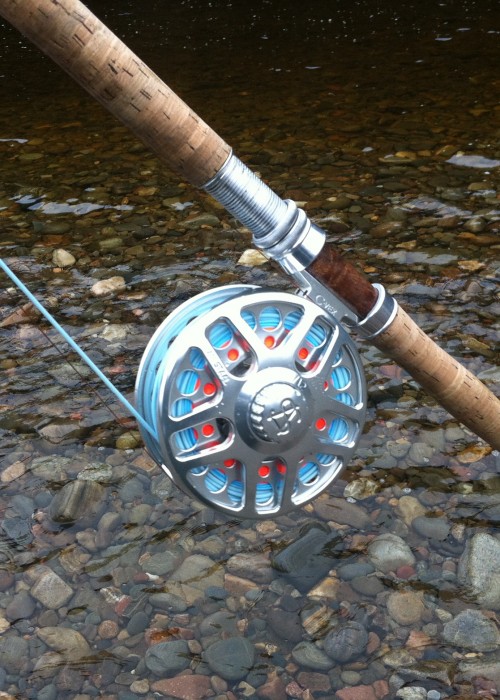
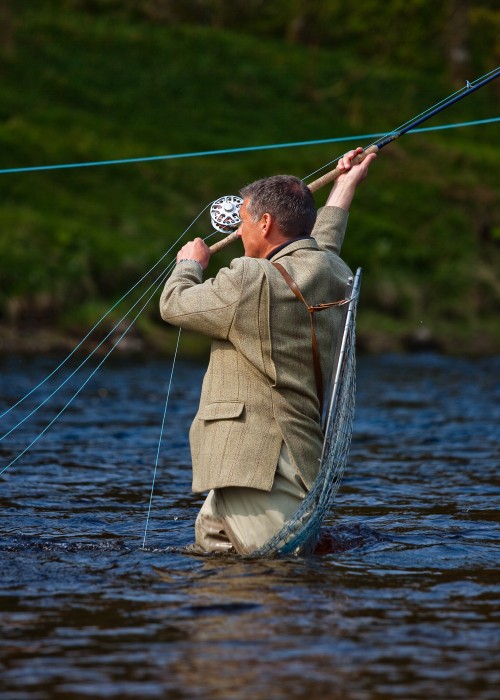
Learn how to perform the traditional Scottish Spey cast with a complete breakdown of the vital components that make up a perfectly delivered Spey cast.
Our renowned guided salmon fishing and instructional days include an effective crash course on the simplicity involved in using a Spey rod which is an elegant and traditional casting method for delivering a salmon fly to the river. Even more important than that is being taught how to effectively move down through a salmon pool and set the hook correctly when a salmon takes the fly. A 'professional' salmon guide who has spent their career on the Scottish rivers is best qualified to deliver this vital instruction. Follow this link to hire a salmon guide in Scotland to teach you how to Spey cast on the famous rivers Tay, Dee, Spey or Tweed. The Spey cast is the most amazing logic based cast of all the different salmon fly casts. The problem can often be obtaining the correct logic based information as to why the beautiful and traditional Scottish Spey cast is the 'true King' of the casting world and what makes it effortless to perform.
This article will perfect the initial 'lifting' of your fly line if you tune into exactly what I state. Drawing your head marker into its optimal casting position marks the start of your cast and for many salmon anglers this is exactly where things can start to go wrong. If the fly line lift is not fully understood it will hinder you throughout your fishing career and you'll likely never get to the bottom of why things aren't consistently working well. The 'eagle eye' of a professional salmon ghillie will spot a poor and ineffectual line lift problem instantly.
Firstly your fly line should be straight below you in the stream and drawn back to the correct length of head for optimal casting weight & length and squeezed tight to cork handle to lock in the line energy. Your body position should be square to the target i.e. approx 45 degrees from the riverbank below you which means if your fly line is straight and parallel to the riverbank below you your upper body should be slightly turned in towards the riverbank at the beginning of the cast but not your feet which should remain facing the target area. Your hands should be low at the start of the cast and your rod tip should be at the 8 o'clock position (clock face across river) or touching the water in order to open up and maximise your line lift range. Always be aware that a salmon fly line with a sink tip will come up through the water column to the surface more effectively if it's 'smoothly & slowly' lifted and not quickly snatched to the surface of the river.
Your lift should start slowly and the rod lift angle should be 100% parallel to the riverbank. As you begin the lift do not start to change the lifting angle of your rod away to the side and keep your rod moving parallel to the riverbank all the way 'slowly' up to a high 11 o'clock rod position. While doing so your hands should be slowly lifting too until your left hand is up near your chin (with a right hand up Single Spey cast) at the same time your rod reaches its optimal 11 o'clock rod position.
Obviously 8 to 11 o'clock with smooth rising hands will be more effective than a 9 to 10 o'clock lift with static hands so what you've really done here is you've opened up the 'lift' range and increased the height of your rod's lifting ability by slowly & smoothly lifting your hands throughout the lift. Any sudden movements including an abrupt stop at 11 o'clock will kill the cast stone dead as the rod will react with a kick creating a pocket of slack in your fly line which represents an instant loss of the intended line energy build up.
Here's what you won't notice or normally ever look for. If the lift starts low as advised and if drawn parallel up to the 11 oclock lift finish position with smooth rising hands the split second your rod tip reaches 11 o'clock all of your fly line will be taught except for the leader and the first yard of sink tip (or front end of your fly line) which will be up on the river surface. The importance of this cannot be over estimated and how this translates logically is that when you then go into the 'swing' section of the cast all you have is 'air resistance' and not line energy build up destroying 'water resistance' which can only be counteracted & corrected by overpowering the rod through the 'swing' which will completely kill the line energy build up you're really trying to achieve.
'Air resistance' is negligible and 'water resistance' through an incorrect low lift is considerable. Until you see the above working you'll not realise how effortless the 'swing' then becomes following a correct and 'vital' high range optimised smooth line lift. In other words if you lift your fly line as advised you can not only build up 100% line energy retention but you will gain complete control of the swing which can then be executed with a smooth even spread energised turn of the shoulders. Incorrect line lifts are why 'shooting heads' are so popular and floating versions of these are mainly used by casting instructors throughout the UK. What's the point though of learning how to Spey cast a Spey line or a shooting head with a floating version if your casting is then going to fall apart when you go into a 'real' fishing situation and have to use a fast sinking tip or sunk line and you don't know how to effectively lift it.
90% of casting errors begin with a poor lift. If you absorb the content above and compare it with how you're currently lifting your line there's likely few thoughts of opening up the lift range, smoothly lifting your hands or what you should be looking for at the leader end and get a very brief glimpse of as 95% of your line aerialises at the optimal 11 o'clock finish point of the lift. Building up line energy is what your real goal is and a nice taut smooth line from start to finish during the Spey cast is what makes it flow and look so easy. The same energy you see when you pull on an elastic band and in a Spey cast this can be easily achieved with a range optimised, smooth 'rising hands' lift which merges seamlessly into a smooth swing to create perfect loading for ease and maximum energy deployment of the final power stroke delivery.
Assuming you've fully understood section one of the cast as high hands momentarily stop the rod pecisely at the top of the lift at an 11 o'clock rod position with the rod up to this point only moving pararrel to the riverbank. At the top of the lift 11 o'clock rod position the rod now needs to change to a high outward angle as the line is smoothly yet assertively swung round to the upstream side of your riverbank position which is known as the 'swing'.
Try not to merge the 2 sections of this cast together too quickly as if you over extend the lift past the eleven o'clock stop position you will reduce you're swing range which will equate to less loading or having to snatch the swing which will have the same negative impact. Open up the rod lift range and the swing range too as the more range areas you create the more effortless these sections of the cast become. The swing should start at 11 o'clock (across stream clock face) at the top of the lift and finish around to the upstream side of you at a 1 o'clock rod position (upstream clock face). If this is done with sufficient smooth rod swing energy a lovely big D loop of line loading will appear between your 1 o'clock rod stop position and the anchor point where your fly line momentarily touches down on the surface of the river.
This also means turning your upper body through the swing and bringing your hands around to the upstream side of you to open up and maximise this swing range. Smoothness of swing is crucial to maintain the nice taut line energy build up from your initial line lift but don't confuse smoothness with slowness as there needs to be a smooth yet energised swing pace applied to bring the rod and line around far enough to an upstream 'anchor point' for optimal loading. This smooth rod swing energy must be 100% evenly distributed as a slow start speeding up mid swing or a fast start slowing down mid swing will not cut the mustard! 100% smooth yet assertive swing energy will keep your line energy build up as taut as my Auntie Jean's drawer's elastic!
Don't dip your rod tip through the swing but maintain a high outward rod tip position all the way through the swing. Dipping your rod tip through the swing as you see many Spey casters doing as they try to draw the D loop with the tip of their rod will only produce shallow loading and it's only an assertive smooth rod swing with a consistent high outward pointed rod tip position that will achieve the best loading and nothing else. Make sure however that the rod swing angle is extended high but outwards enough to keep the salmon fly away from you as it passes you through the swing.
The positioning of the anchor point which is where the front metre of you salmon line briefly touches down on the surface of the river prior to the power stroke is dependent on what type of loading you require for the cast and how much space you have. A perfect lift and smooth controlled swing will completely put you in control of the anchor point position and if these are done correctly the anchor point should be angled in a perfect straight line at roughly the optimal angle the line has to be delivered from the water at. If your anchor point isn't creating this optimal shape on the river's surface for a slick departure it is a guarantee that there is an error ocurring in your lift or swing. Even with a bulkier slightly more difficult to control shooting head or Skagit line a smooth swing will lay the line down as described above. View the anchor point positioning as pulling back on a bow as the further you pull it back the more power you are going to create. There's no right or wrong as to the exact postioning of the anchor point on the surface of the river as long as it's approximately one rod length away from your shoulder. That area is a safe area where an unexpected gust of wind is highly unlikely to blow the fly into you as you apply the power stroke. In saying that and even for highly experienced Spey casters suitable eye protection should be worn at all times.
Most salmon anglers fish like 'racehorses with blinkers on' but if you wish to get your timing 'off the water' precisely correct as the line touches down and your hands are round at the side of you with the rod held high at a 1 o'clock rod position and a big D loop of line loading has naturally formed it is advantageous to watch your anchor point. As you fish down through most salmon pools your height above the waterline will usually be changing & adjusting frequently (which often goes unnoticed) which means so should the timing of your power stroke delivery. To get this absolutely right use your peripheral vision to tell you exactly when to apply the power stroke instead of trying to guess it or rely on a sense of timing which may not be sharp enough yet if you're new to the cast. The anchor point only needs to be kissing the water for a brief second when the time will be right to send it away. Watch the anchor point then turn your vision onto the target area after you've applied the power stroke is the most logical procedure and don't get caught up with 'target fever' as the distance will take care of itself if your timing 'off the water' is perfect.
With the above in place you've now tuned your peripheral vision into the anchor point to make sure your timing 'off the water' is precise. You've also brought this anchor point far enough round to make sure you're creating sufficient loading but to also keep the fly approx one rod length away from you for personal safety reasons even though you're wearing suitable eye protection. Now everything is set up perfectly for a sweet forward 'power stroke' delivery.
The anchor point only needs a brief second and no more than that before sending it away and the sound 'off the water' will tell you whether you're too slow or too fast. If you're too slow you'll hear a 'slooshing' sound which is a waste of line energy that should have gone to the forward delivery. If you're too fast and you hear a 'whooshing' sound which means you've come in a split second too early and missed the anchor point. What you want to hear is the sound that's right between these 2 noises which is the sound of absolutely 'nothing' which ensures the anchor point was achieved perfectly and all of the line energy build up has gone to the fly and not been wasted.
At this spilt second of Spey cast set up perfection with everything understood and in place all that is now needed is to fully understand how to get the best from the action of your rod to power the fly line out across the salmon pool. Many Spey caster think it's about throwing the rod at the river but it is most definitely not the case. A maximised power application cast with any fishing rod involves a sharp 'stop' of the rod. It is this 'stop' that unleashes a rod's power and with the forward stroke of a Spey cast it is no different. This almost invisible 'stop' on the forward power stroke should come in at the 11 o'clock (upstream clock face) rod position. The split second after this stop is applied release your squeeze on your fly line against the cork handle to shoot running line. Running line management should always allow the smallest loop of line to go first on the power stroke and no more than 3 big loops in your 'running line management' should ever be considered to avoid a fankle.
Powering the rod forward from the 1 o'clock (end of swing) position to this high forward 11 o'clock barely noticeable stop position forces the rod to kick forward and also set your fly line off at the optimal trajectory for distance at the same angle of release as if you were launching a stone across the river. A low incorrect stop will set your fly line off on a downward angle which will be indicitive of the belly of the fly line landing on the river first instead of the entire line extending to full casting length, straightening and landing all at once. Once this split second high forward 11 o'clock stop has been applied then lower the rod to lower the trailing running line in the air. If you don't do this your fly will likely catch your mainline on the way out so don't leave the rod tip static at 11 o'clock when you've applied the power stop.
Your body throughout the cast should be angled at approx 45 degrees out from the downstream riverbank (facing the target area) and to maximise your swing and power stroke range you should be rotating your upper body to the left and then to the right from the start of the lift to the stop position at the end of the swing. This way when you go to apply the power you're also bringing in your upper body movement into the cast which will give you even more torque. Your hands should be high throughout the cast and should not vary from your high hand position at the top of the lift right through the swing to the moment the forward power stoke delivery is applied. The hands can be lower after the power is applied.
If you are performing a Single Spey cast with a right hand up rod position and you've brought the anchor point round into position you should push your left hand out away from your body before you apply the power. The most power in a forward power stroke delivery comes when both hands are brought into play in unison and as the right hand is driving the forward power your extended left hand should be sharply pulling the rod butt in close to your chest. The extra efforless rod speed you'll achieve from this dual hand technique will far outweigh what you can achieve with just the right hand driving everything on its own.
Understanding and mastering these three steps 'The Lift' & 'The Swing' and the 'The Power Stroke' are what I personally regard as 'crucial' for perfecting the most satisfying salmon fly fishing cast of all. If your brain understands exactly what you should be doing during each stage of this cast then your hands will automatically be programmed to follow. If you compare each stage of the cast as specified with what you're currently doing it's likely you'll find one or two minor things I've mentioned that will significantly assist your total enjoyment and effectiveness with this magnificent & traditional salmon fly delivery system.
All of the above Spey casting components can be learned on one of our renowned guided salmon fishing days. Follow this link to book a professional salmon fishing guide.